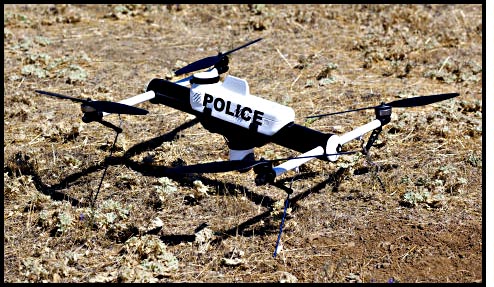 According to a post in the Caldwell Guardian, the Caldwell police department recently spent a big pile of money on an unmanned aerial system (equipment, training, etc.). The photo (shown left) is not necessarily the unit purchased.
According to a post in the Caldwell Guardian, the Caldwell police department recently spent a big pile of money on an unmanned aerial system (equipment, training, etc.). The photo (shown left) is not necessarily the unit purchased.
It is no surprise that civilian law enforcement would be encouraged by unmanned aerial vehicle (UAV) manufacturers to buy UAVs for police surveillance and operations. The US military and intelligence community has paid millions if not billions of dollars for their development. As first generation UAVs evolve to second generation and then third generation and so on, the manufacturers will be trying to get rid of technological inventory at bargain basement prices.
But should US civilian law enforcement be using UAVs? What are the constitutional issues? Should US civilian law enforcement be able to deploy weaponized UAVs? Under what circumstances?
The issue has become large enough for Congress to begin looking at it. To help the hired help in Fantasyland-on-the-Potomac get somewhat up to speed, the Congressional Research Service has published Drones in Domestic Surveillance Operations: Fourth Amendment Implications and Legislative Responses . It was released September 6, 2012.

We were at dinner tonight with friends who told us that our military has developed drones the size of mosquitoes that can land on people and take DNA samples, as well as audio and video recordings. Is this true? Can they legally be deployed within the U.S. to spy on regular people? This is like something out of Ray Bradbury’s “Farenheit 451”.
That just happens to be one of my favorite books — did you realize that Ray Bradbury wrote it in 1953, the year I was born, and he describes people living in houses with whole walls as TV screens. (We’re almost there now) They had two, three or all 4 walls of their living rooms as TV screens, and they would wear little sea shell shaped ear pieces (think ipods) to communicate with the characters in the walls. Books were banned because they told of history and events the government didn’t want people to remember. The main character breaks away and reads some contraband books. He has to run for his life because mechanical drone-like flying things come after him and attempt to inject him with deadly poison.
It’s an amazing story from a man who, in 1953, was so poor he had to go to the UCLA library (he couldn’t afford to attend the university) at night, after work, to pay 10 cents per page to type out his book on a typewriter there. It is one of the classics. I’m not a SciFi nut, but it’s a terrific book, scary in it’s vision of our plight today, almost 60 years later.
Comment by mary — September 7, 2012 @ 10:34 pm
Mary,
I’ve little doubt that using nanotechnology to reduce the sizes of robotic surveillance platforms is being researched, but as far as I know, the technology is still not there for production and operational deployment. Often the biggest component of microminiature surveillance technology turns out to be the power source. The benefit of nanotechnology is that it will consume far less power than the stuff presently available, and as a result, that will drive power cell size down. I’m sure the low serial number production stuff, when and if it ever hits the market, will be high-priced military and spookville stuff rather than in civilian law enforcement. Until then, my guess is that the mosquito I just swatted is still just a mosquito.
Still, it might be fun to see a nanotech spook moth fly into a bug zapper — and cause a brown-out in the northwest.
Comment by Bill — September 8, 2012 @ 9:47 am